Tagines are at the heart of Moroccan cuisine; the tantalizing aromas that flow from these clay pots are integral to the country’s rich culinary heritage. With a history that stretches back centuries, the Tagine has evolved into a model symbol of Moroccan cooking, and it’s a dish that has won over the hearts of food lovers worldwide. But what makes this humble pot so unique? In this article, we’ll explore Tagine’s history and cultural significance. Moreover, we’ll delve into the different types of tagines, from meat to vegetable, and offer tips and tricks for cooking the perfect Tagine at home.
The History and Cultural Significance of Tagines in Moroccan Cuisine

Tagine is a Moroccan dish integral to the country’s cuisine for centuries. In Moroccan cuisine, people traditionally cook it in an earthenware pot called a “tagine.” However, the term has also come to be used to refer to the plate, which typically consists of a stew made with meat, vegetables, and spices.
The Berber people, who used the clay pot to cook food over charcoal fires, can be traced back to the origins of Tagine. Over time, the dish became a cornerstone of Moroccan cuisine and a symbol of hospitality, often served to guests as a sign of respect and friendship. As the dish spread throughout Morocco, it became associated with traditional family meals and special occasions. Furthermore, as Tagine grew in popularity, different regions of Morocco developed their dish variations.
The intricate designs and patterns that embellish Tagine pots hold significant cultural significance. Skilled Moroccan artisans meticulously handcraft and paint these tagines, with many reflecting the unique characteristics of the region in which they are made.
Understanding the Different Types of Tagines and Their Uses in Moroccan Cooking
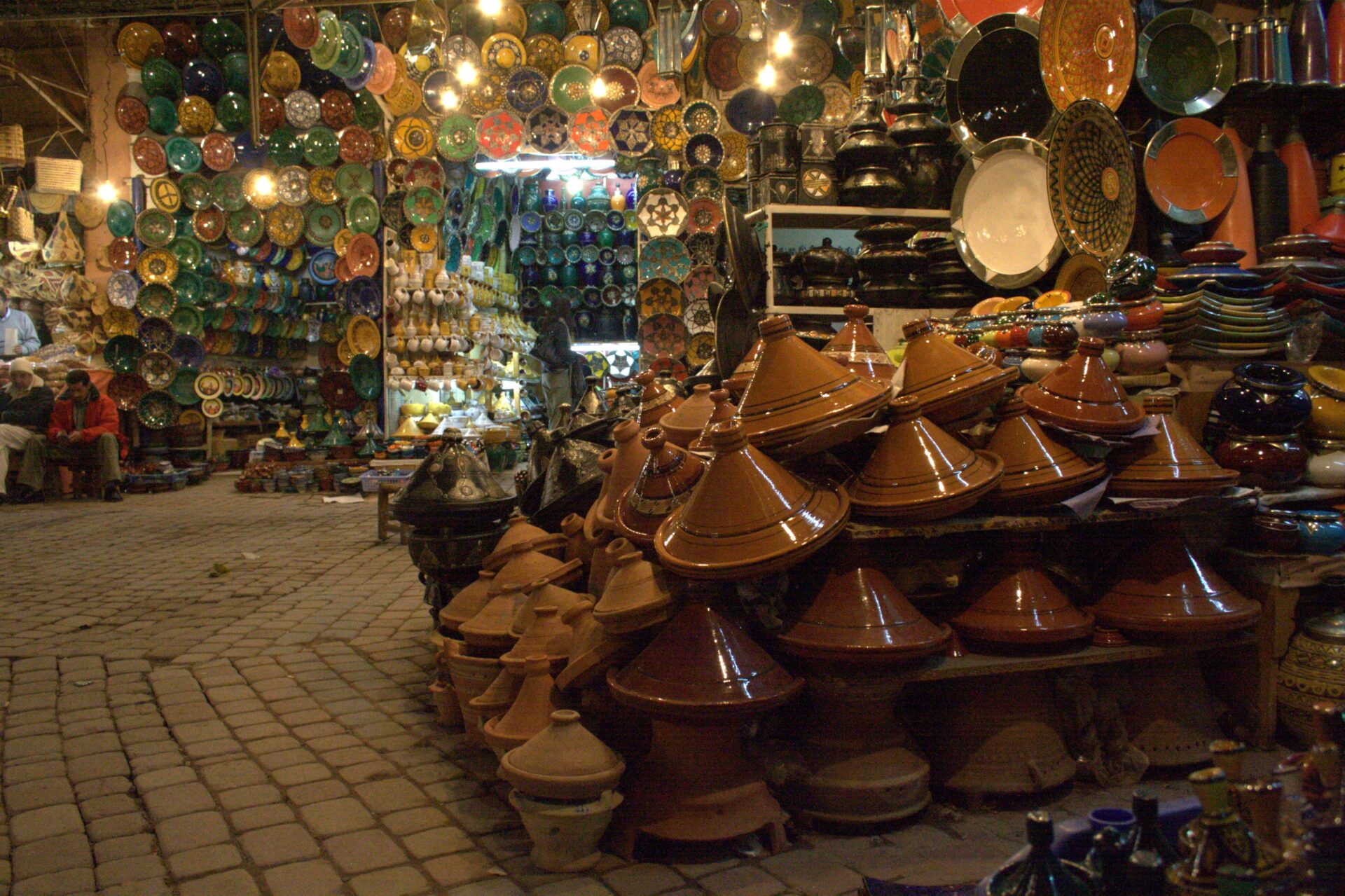
Regarding Moroccan cuisine, the Tagine is the centerpiece of its flavor and aroma. The clay pot’s unique shape and conical lid make it ideal for slow-cooking stews and other dishes. However, Tagines come in various forms, sizes, and materials, each with distinct properties and uses.
Moroccan cuisine includes various tagines, with the traditional clay Tagine being the most commonly used. The shallow and broad base of the Tagine makes it ideal for slow-cooking stews, vegetables, and meats. The conical lid traps and condenses the steam, creating a moist cooking environment that tenderizes the ingredients and infuses them with flavor. Glazed ceramic tagines, on the other hand, offer a more contemporary interpretation of the traditional clay tagine. These tagines come in various colors and designs, reflecting the artisan’s creativity and style. They are versatile and suitable for preparing soups, stews, casseroles, and serving dishes.
Lastly, electric tagines are a recent innovation that allows easy cooking without an open flame. These tagines are non-stick and have a built-in electric heating element for easy temperature control, making them perfect for people who want to enjoy the flavors of Moroccan cuisine without the nuisance of traditional cooking methods.
In summary, Tagines are essential in Moroccan cuisine and come in different shapes and sizes, with traditional tagines for slow-cooking stews, ceramic ones for stovetop and oven use, and electric ones for hassle-free cooking. Whichever type you choose, this iconic dish’s rich flavors and aromas are guaranteed to satisfy you.
Traditional Tagine Recipes: From Meat to Vegetarian Options
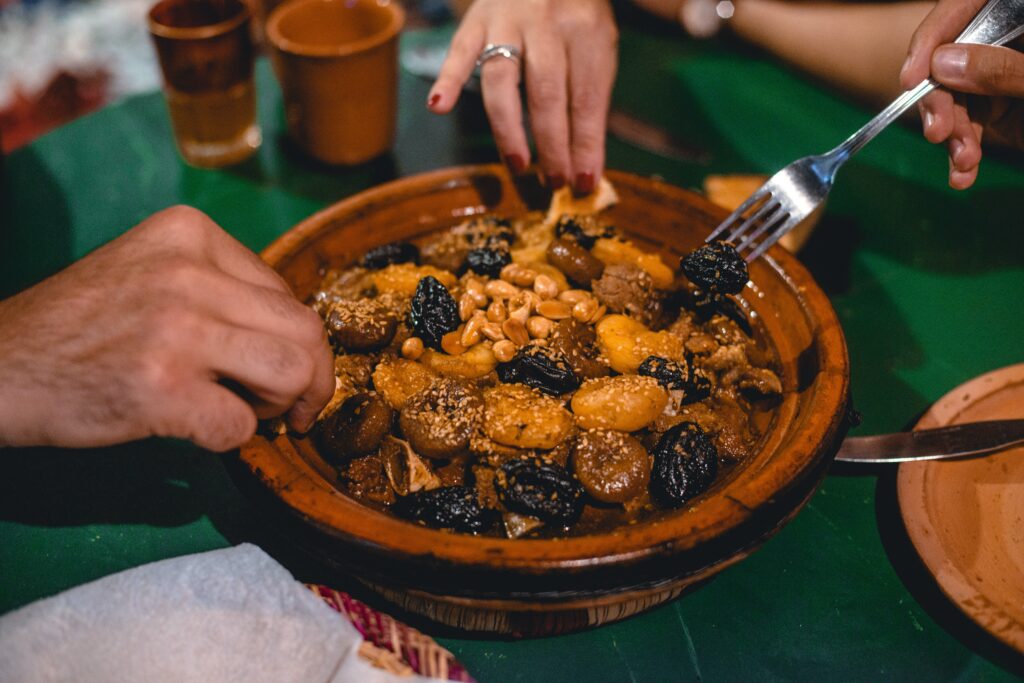
Moroccan cuisine is incomplete without Tagine, a traditional dish from the Berbers that has been a fixture for centuries. With its versatility and unique blend of ingredients and spices, Tagine has something for everyone.
To experience the authentic taste of Morocco, try cooking one of the many traditional Tagine recipes at home. Chicken Tagine with Preserved Lemons and Olives is a popular choice, combining the savory flavor of chicken with tangy preserved lemons and salty olives. Meanwhile, Lamb Tagine with Prunes and Almonds features slow-cooked lamb with a blend of sweet and savory spices, topped off with prunes and almonds for added sweetness.
Vegetarian diners will love the Vegetable Tagine with Chickpeas and Spinach, cooked with honey and spices, resulting in a delicate balance of flavors. For seafood lovers, Fish Tagine with Tomatoes and Peppers is a light and flavorful dish that blends Moroccan spices with fresh fish, tomatoes, and bell peppers.
Finally, the Beef Tagine with Prunes and Caramelized Onions is comforting and satisfying. This Tagine showcases tender beef cooked with prunes, caramelized onions, and a blend of spices, such as cinnamon, ginger, and saffron.
Try one of these Tagine recipes at home to experience Moroccan cuisine’s unique flavors and spices. With a range of options for meat lovers, seafood enthusiasts, and vegetarians, Tagine is truly a dish for everyone.
Tips and Tricks for Cooking the Perfect Tagine at Home
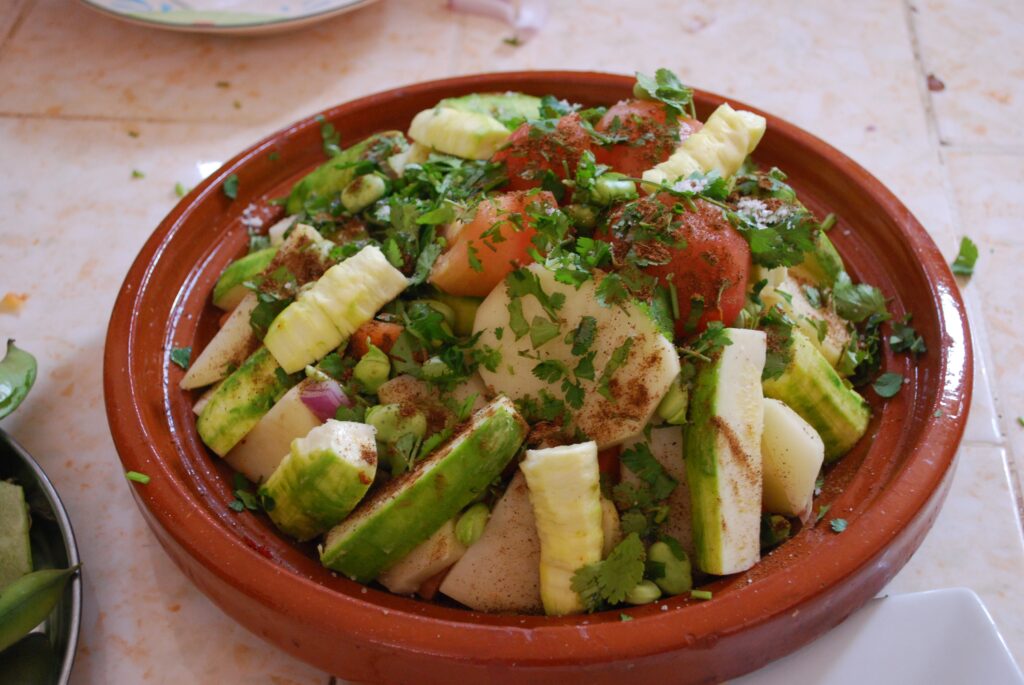
Cooking an authentic tagine can be daunting, especially if you’re new to Moroccan cuisine. However, you can create a tasty and authentic tagine in your kitchen with the right tools and techniques. Here are some tips and tricks to help you cook the perfect Tagine at home and bring the heart of Moroccan cuisine to your table:
Select the Right Tagine Pot: A tagine pot is essential for cooking tagines, traditionally made of clay material that evenly distributes heat. When selecting a tagine pot, ensure it suits your stovetop and oven.
Season Your Meat: Seasoning your meat with the right spices is essential before cooking. Use a combination of cumin, coriander, paprika, and turmeric for a traditional Moroccan tagine.
Incorporate Plenty of Vegetables: Tagines usually contain vegetables, such as onions, carrots, potatoes, and tomatoes. These vegetables not only add flavor and nutrition but also help to create a rich and hearty broth.
Use Low Heat: Tagines should cook slowly over low heat, gradually allowing the flavors to develop. This slow-cooking method ensures the meat becomes tender and falls off the bone.
Avoid Opening the Lid: Resist the temptation to lift the lid of your tagine pot to check on your dish. Each time you open the lid, heat escapes, and the cooking process slows down.
Finish with Fresh Herbs: Add a sprinkling of fresh herbs to your Tagine to enhance the flavor before serving. Cilantro and parsley are traditional choices, but you can experiment with mint, thyme, or rosemary.
Following these tips and tricks, you can make a delicious and authentic tagine at home. Experiment with spices, meats, and vegetables to discover your perfect flavor combination.
Exploring the Best Places to Enjoy Tagines in Morocco
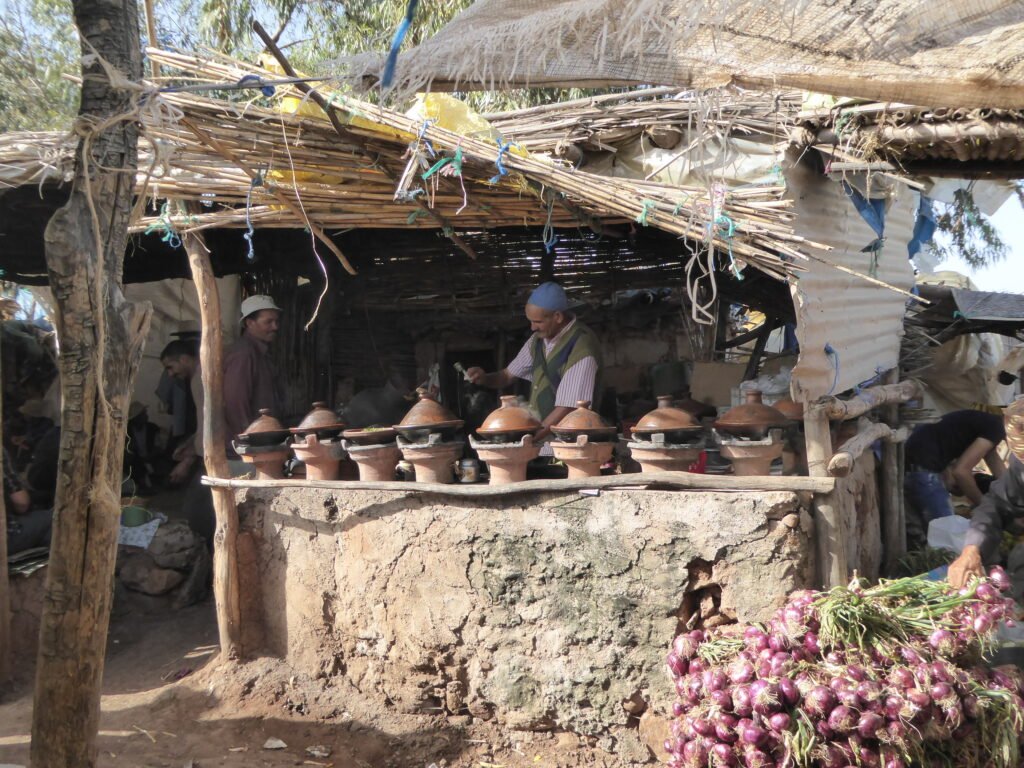
Locals and tourists alike love tagines, which have been a mainstay of Moroccan cuisine for centuries. In Morocco, you can find a tagine that suits your taste buds, whether you’re interested in street food or high-end dining. Here are some of the top places to visit if you want to sample the country’s best tagines:
Marrakech is a must-see destination for food lovers, with Jemaa el-Fnaa square offering a range of tagine stalls serving meat and vegetables.
Fez is another famous city for foodies, where you can try a lamb tagine at Restaurant Dar Hatim or a chicken tagine with preserved lemons and olives at Restaurant Palais Amani.
In Casablanca, you can find restaurants that blend Moroccan flavors with international cuisine. Check out Le Cabestan for a seafood tagine or Le Petit Rocher for a vegetarian option.
Essaouira, a coastal town, is renowned for its fresh seafood, including fish tagine with chermoula or squid tagine with vegetables.
Chefchaouen, a picturesque town in the Rif Mountains, is an excellent place to try a meat tagine. Head to Casa Hassan for a lamb or beef tagine cooked in an earthenware pot.
Wherever you go in Morocco, you will find a delicious tagine to savor, whether you prefer meat, seafood, or vegetarian options. Add this iconic Moroccan dish to your culinary bucket list and explore the best places to enjoy it throughout the country.
Pairing Tagines with Moroccan Side Dishes and Desserts
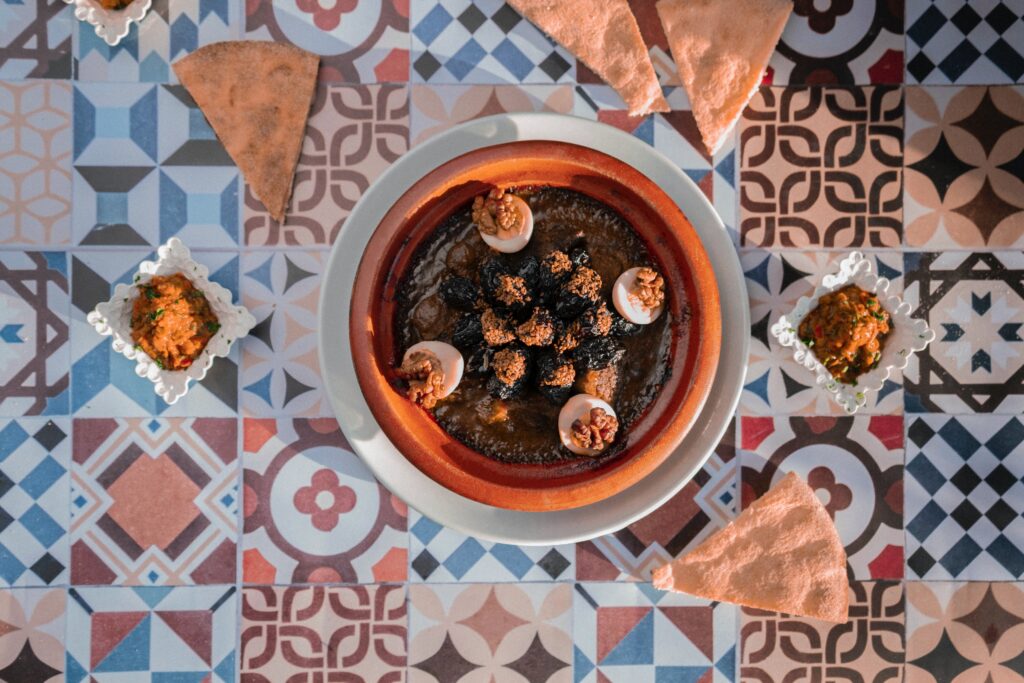
Tagines are undoubtedly the heart of Moroccan cuisine. Still, every meal in Morocco is complete with a selection of side dishes and desserts to complement the flavors of the main course. We’ll explore traditional Moroccan side dishes and desserts that pair perfectly with tagines.
Moroccan Salads: Moroccan salads are the perfect accompaniment to tagines. They are light and refreshing, and their bright flavors complement the rich and savory flavors of the Tagine. Some popular Moroccan salads include zaalouk, a roasted eggplant and tomato salad, and taktouka, a roasted red pepper and tomato salad.
Bread: Bread is a common accompaniment in Moroccan cuisine and is often used to scoop up the Tagine. Khobz, a Moroccan bread, is the perfect choice to pair with tagines as it is sturdy enough to hold the stew without falling apart.
Harissa: Harissa is a spicy paste made from chili peppers, garlic, and spices. It is commonly used as a sauce in Moroccan cuisine and pairs perfectly with tagines. A small dollop of harissa on the side of your Tagine will add an extra kick of flavor.
Moroccan Mint Tea: A cup of sweet Moroccan mint tea is the perfect way to end a tagine meal. It’s a traditional Moroccan beverage with fresh mint leaves, green tea, and sugar.
Fruit Salad: A simple salad made with fresh Moroccan fruits such as oranges, pomegranates, and figs is a great way to end a tagine meal on a light and refreshing note.
Tagines are an essential part of Moroccan cuisine, and selecting the perfect sides and desserts to pair with them can take your meal to the next level. By following these recommendations, you can create an authentic and mouth-watering Moroccan dining experience in the comfort of your own home.
Conclusion
Tagines embody the heart of Moroccan cuisine and are more than just a dish. These slow-cooked stews, found in almost every corner of the country, are a labor of love, and each recipe has unique flavors. Cooking a tagine is an excellent way to experience Morocco’s rich and authentic taste. Whether you prefer traditional meat, lamb, or vegetable tagines, exploring the world of tagines is a culinary adventure worth undertaking for cooks of all levels. It’s also a great way to discover Moroccan cuisine’s heart and offerings.


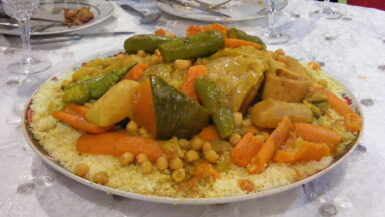
Leave a reply